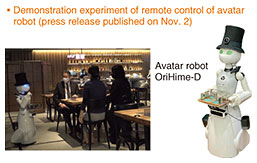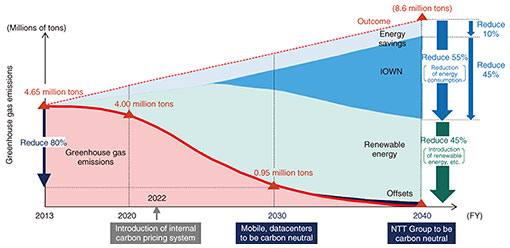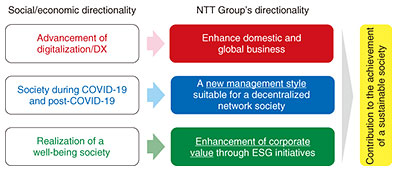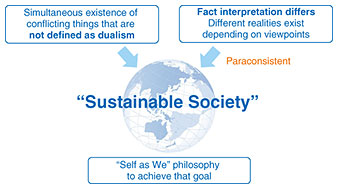 |
|||
|
|
|||
|
Feature Articles: Keynote Speeches at NTT R&D Forum—Road to IOWN 2021 Vol. 20, No. 2, pp. 11–18, Feb. 2022. https://doi.org/10.53829/ntr202202fa1  What is IOWN?AbstractThis article introduces initiatives to expand the use of the Innovative Optical and Wireless Network (IOWN) called the “Road to IOWN.” It is based on the keynote speech given by Jun Sawada, president and chief executive officer of NTT, at the “NTT R&D Forum—Road to IOWN 2021” held from November 16th to 19th, 2021. Keywords: IOWN, All-Photonics Network, bio digital twin 1. Road to IOWNLet me today introduce our initiatives to expand the use of the Innovative Optical and Wireless Network (IOWN) called the “Road to IOWN.” Before that, I would like to reflect on recent natural disasters, which have become much more severe than in the past. In the summer of 2021, a disastrous landslide occurred in Atami City, Shizuoka Prefecture in Japan, and in Germany, about 200 people died in torrential rains and floods. There were also the earthquake in Haiti and wildfires in California. On top of all that, the threat of the novel coronavirus (COVID-19) pandemic has changed our lives dramatically over the last two years. The pandemic has made remote work (work from home) more widespread and has made it difficult for people to meet in person. Along with the world becoming more connected through the Internet, problems such as crimes related to the Internet and overflow of information with varying quality called “infodemic” have been increasing. From a different viewpoint, a lesson learned from natural disasters and pandemics is, “Nature is full of unexpected things.” We should be aware that unexpected things are happening all the time and are out of our control. Therefore, what conclusions can be reached when the situation is so unexpected and uncontrollable? The means of trying to explain the world using natural science is called “naturalism.” As the idea of naturalism alone cannot deal with natural disasters, it is necessary to take a broader view of preparation that goes beyond what is scientifically understood. The world cannot be explained by logic alone. Jakob von Uexküll, a German biologist and philosopher, thought about this problem in a different way and came up with the concept of the “umwelt” (“environment” or “self-centered world” in English) (Fig. 1). Umwelt may not have received much attention in current academic circles. However, we may need to apply this concept of umwelt when we think about unexpected things as the scale of natural disasters is increasing and people tend to be more easily divided due to the development of social networking services (SNSs), etc. By applying this concept to the direction in which technology should advance, we aim to expand the area in the human umwelt occupied by information processing, which is currently very small. In other words, the goal is to achieve a situation closer to nature. For example, broadband enables high-speed, high-capacity data transmission. This technology is based on the idea of recreating a situation close to nature. Meanwhile, our communication devices have evolved from fixed-line telephones to smartphones, and at each evolution, we need to learn how to use new devices, which results in putting load on humans. This situation is far from natural. Technology, which can naturally support the human desire to communicate and convey our thoughts, will lead our world to greater happiness.
2. Bio digital twinResearchers at NTT Research, Inc. in the United States are working on reproducing the physical and psychological states of humans in cyberspace (Fig. 2). They are currently focusing on modeling the heart. This research will support treatment based on predictions by modeling and simulating hemodynamics from blood-flow data and visualizing the cardiopulmonary state. They have also started contributing to preventive medicine for illnesses such as heart disease and failure. Bio digital twin is another example for making information processing closer to nature.
2.1 Using non-human umweltenThe world perceived by humans with our five senses, or six senses, differs from that perceived by insects, fish, animals, and other organisms. As I mentioned in the previous NTT R&D Forum, birds and bees see things in ultraviolet light, while humans do so in visible light. If we could see things in ultraviolet light, a whole new world would be opened up. That is to say, we would make our world closer to nature. For example, dolphins emit ultrasonic waves (at a frequency of about 150 kHz) by shaking folds at the back of their throat near their vocal cords, while humans can only hear sounds up to about 20 kHz. This means that dolphins can communicate via very-high-frequency sounds compared with humans. Dolphins also have a bump on their forehead called the “melon organ,” which has a mechanism for effectively transmitting and receiving ultrasonic waves in the targeted direction. While humans do not have such a mechanism, NTT laboratories developed a method of listening to music and other sounds called the “personalized sound zone” by using the mechanisms, technologies, and principles inspired from dolphins. We established a company called NTT sonority, Inc. in September 2021 and are currently developing new products. Turning space into information to make people more comfortable will improve well-being and bring information from a different umwelt to that of humans. While the umwelt is traditionally characterized by species, human communities are more than ever characterized by only information they are comfortable with as we now live in a divided world. That is, we are entering an era of fragmentation, in which several umwelten are created in human communities. We need to figure out how to connect them, and I believe that the Innovative Optical and Wireless Network (IOWN) will be the medium to connect each umwelt to make information processing in the human umwelt closer to nature, apply the mechanisms of non-human umwelten to the human umwelt, and close the communication gap between people. 3. All-Photonics NetworkThe framework of IOWN consists of three major layers and four functions. The first layer is the All-Photonics Network (Fig. 3). The idea behind the All-Photonics Network is to use optical fiber across the entire network, replace the semiconductors that process information with optical technology, and use optical computers. The All-Photonics Network will support high-capacity, low-latency, and low-power-consumption communication. A data-driven society generates huge amounts of packets and information data. The datacenters that store, transform, and process such data generate heat like a toaster and are currently cooled inefficiently by using fans. Optical technology will change this situation by reducing heat generation drastically. Such technological revolution should bring about breakthrough innovations.
On top of the All-Photonics Network are the fixed and mobile networks as the second layer, in which many companies provide services around the world. Fifth-generation mobile communication networks (5G) are now being offered, and after that comes the era of 6G. The third layer is Digital Twin Computing. In this layer, objects in real space are reproduced in cyberspace such as a bio digital twin as described previously. These three layers are connected via a multi-orchestrator, and the entire structure is called Cognitive Foundation®. We will live in a world in which various businesses will compete and cooperate with each other, and Cognitive Foundation® will be the key to promoting such competition. IOWN is formed by the elements of interconnection and interoperation. Several use cases of the All-Photonics Network have started in 2021. 3.1 Avatar robot café DAWN Ver.βI’ll introduce the comment by Yoshifumi Shiiba, director and chief technology officer of OryLab Inc. “DAWN is a café where people with physical disabilities can use the power of the Internet and technology to work in the same manner as able-bodied people (Fig. 4). We are conducting a series of experiments to determine how moving an avatar robot [OriHime-D] in a low-latency network condition affects actual tasks. Thanks to the high-speed communication provided by IOWN, the robot can move smoothly along narrow routes and get to its desired destination reliably even if that location is not predetermined, which was not possible when using the ordinary Internet.
It is not human-like to move along a predetermined route, in a predetermined form, and in a predetermined order. Unfortunately, OriHime-D operating over the ordinary Internet cannot act exactly the same as able-bodied people such as flexibly handling unplanned tasks and oral requests on the spot. If high-speed networks could be expanded, all five senses could be transmitted to the customer’s location, and people with disabilities could work as if they were at that location. As a result, they would have a wider range of tasks they could handle, and many things would become feasible for them. I also believe that the differences between disabled and non-disabled people would become less. I would be pleased if we could create such an environment.” I had talked about this avatar robot café with Kentaro Yoshifuji, CEO of OryLab Inc. six or seven years ago. People like us, who work in communication industry, thought that “interactivity” was the basis of communication. For example, when we develop communication services, we assume that they will be able to communicate in both directions, but OriHime can only communicate one-way. It uses unidirectional video to communicate, so only the pilot—a person with disabilities—can see a customer but the customer cannot see the pilot. Therefore, it does not convey information in two directions; rather, it conveys its presence in one direction. Such two-way and one-way communication systems will probably exist naturally in the future. When such systems are controlled remotely, latency often becomes a problem. In this demonstration experiment with OriHime, we were able to connect NTT Musashino R&D Center in western Tokyo to Nihonbashi in central Tokyo and move the robot with a delay of less than 20 ms. Since such remote control is normally operated in about a 400-ms delay, we were able to achieve remote control with 1/20 the normal delay. 3.2 Cloud-based e-sports eventsOne of the most effective use cases of the All-Photonics Network is in cloud-based fighting games. In such games, it is important to stream 8K video with a delay of less than 20 ms. When we compare the environment of a few milliseconds delay and 20–30-ms delay, we can clearly recognize the timing gap of two game characters’ actions. In an environment where the timing of kicks does not match due to the delay, it is difficult to play. While the delay is still 20 ms in the case of OriHime mentioned above, we are now working to reduce it to a few milliseconds. We are also currently researching and developing a system that can synchronize actions of game characters by controlling the delay in the order of microseconds. 3.3 Security in the age of quantum computingAnother use case of the All-Photonics Network is security. We developed an encryption method by combining conventional methods (e.g. RSA (Rivest–Shamir–Adleman) cryptography) with a cipher method called NTRU (Nth Degree Truncated Polynomial Ring Unit) (Fig. 5) on the basis of the computational difficulty of the lattice problem. Commercialization of this encryption method is currently underway. The information processed with this encryption method cannot be deciphered even with quantum computers.
In the All-Photonics Network, the delay time can be evaluated in advance. As the delay time changes when somebody eavesdrops or accesses without authorization, it is possible to instantly detect whether there was an external access. Even though NTRU prevents the information from being deciphered whenever the network is eavesdropped, we aim to make the network capable of detecting eavesdropping as well. 4. Advances in photonics-electronics-converged devicesCurrent semiconductors generate a large amount of heat as they are operated by electrons (Fig. 6). To address this issue, we are researching and developing a photonics-electronics-converged device that will enable inter-chip optical transmission and plan to announce it at Expo 2025 in Osaka, Japan. By 2030, we aim to make a photonics-electronics-converged device that enables both inter-chip and intra-chip optical transmission.
In the era of IOWN, various elements will be combined to form a single system. For example, in the late 2020s, photonics-electronics-converged chips will be applied to mobile communication facilities. In addition, a new optical interconnect device (called super white box) that transcends the traditional concept of the server is planned to be introduced. 5. Toward achieving carbon neutralityIn 2013, NTT Group emitted about 1% of Japan’s greenhouse gas emissions, which was about 4.65 million tons per year (Fig. 7). To reduce greenhouse gas emissions, we will promote energy conservation and use renewable energy. However, the amount of greenhouse gas emissions will still increase if we only take these measures without any other solutions since the amount of electricity usage increases in conjunction with the increase in information processing. To achieve carbon neutrality, we need to leverage the power of IOWN.
We aim to achieve carbon neutrality in the datacenter and mobile sectors by 2030 and throughout the entire NTT Group by 2040. We must solve environmental problems through innovation and drive economic growth simultaneously. While these goals are contradictory, we will tackle them with a paraconsistent approach. We believe that we can contribute to reducing the environmental impact of the entire society through the introduction and expansion of IOWN. 6. How to transform NTT GroupWe are currently focusing on three pillars to transform NTT Group (Fig. 8). The first pillar aims to strengthen our domestic and global businesses as digitalization and digital transformation (DX) spreads around the world. Regarding the second pillar, in both “corona” and “post corona” societies, we need to introduce a new management style to cope with the transition as we move toward a decentralized society. The third pillar is to increase our corporate value through ESG (environmental, social, and corporate governance) and other initiatives to maximize the well-being of our society. Through the initiatives of these three pillars, we aim to contribute to creating a sustainable society.
7. Transformation to a new management styleWith regard to the reform of our management style, we have continued and strengthened remote working during the COVID-19 pandemic. As a result, employee satisfaction, especially among those raising children, has improved. This fact shows that remote working can mitigate some of the issues brought by childcare and both parents working. Looking ahead to the future, we would like to further promote a “work-in-life” (health management) approach (Fig. 9).
8. Sustainable societyLet us think about what kind of sustainable society we aim for. First, it is a society that cannot be understood by dualism. Next, as the word “diversity” implies, it is a society that simultaneously embraces and puts into practice various viewpoints and ideas. To achieve this sustainable society, the concept of “Self as We” becomes the basic philosophy (Fig. 10).
Our society has generally been operating under the concept of “Self as I”—which is about valuing the individual. According to biologist Dr. Shinichi Fukuoka, no organism can transcend its species. However, humans have overcome the idea that only they and their offspring are important. In other words, humans have developed as individuals who are not limited to genetics. For example, only humans can have the concept of inclusion of members of the LGBTQ (lesbian, gay, bisexual, transgender, queer) community. If we look further into the next era, our alter egos will extend to cyberspace. In cyberspace, you will also be able to have your own family, friends, and community. This world is also based on “Self as We,” rather than “Self as I.” I believe we should adopt such a philosophy. The concept of “Self as We” is that; i) nature is an altruistic force and we are a part of it, ii) culture and society are secured by connecting us through ethics, and iii) one’s happiness and other peoples’ happiness coexist (altruistic coexistence). Accepting the concept of “Self as We,” we set the following three themes to achieve a sustainable society; 1) ensure the coexistence of nature and humanity, 2) improve prosperity for all people and cultures, and 3) maximize well-being for all (Fig. 11).
We established NTT Group Global Sustainability Charter on the basis of the above-mentioned “Self as We” concept and three themes. Along with this charter, we specified our Environment and Energy Vision, New Management Style, and Human Rights Policy, which were shared within entire NTT Group globally [1]. 9. Concluding remarksI have talked a lot today, and my book, “Paraconsistent World,” which is about to be published, covers more details through discussion with various experts. I hope you will find an opportunity to read it. Reference
|
|||











